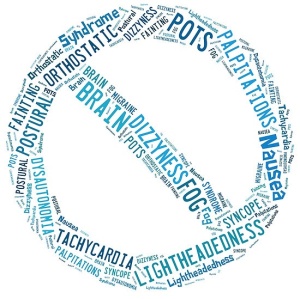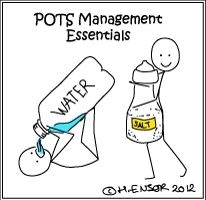This is my second post for Dysautonomia Awareness Month 2014. If you haven’t already, please see my first post which provides a description of Dysautonomia and offers an insight into what a typical day is like for a sufferer. In this post I want to provide you with a more in depth description of POTS – a form of Dysautonomia – which is the illness that I suffer from. I am also hoping this will be a useful resource for myself and other sufferers to share with friends and family who want to know more about POTS.
Postural orthostatic tachycardia syndrome (POTS)
POTS is an exaggerated increase in heart rate (HR) when standing. A healthy person usually has a minor increase in HR —by about 10 beats per minute— when standing. POTS is considered present if the heart rate increases by 30 beats per minute or more when standing, accompanied by nasty orthostatic symptoms.
How does upright posture cause problems?
When a healthy person stands up, gravity causes about 10-15% of their blood to settle in the abdomen, legs, and arms. This pooling of blood means that less blood reaches the brain, the result of which can be a feeling of lightheadedness, or even fainting. For most of people, this lightheaded feeling is rare when they stand up because the leg muscles help pump blood back up to the heart, and because the body turns on a series of rapid reflex responses. To make up for the lower amount of blood returning to the heart immediately after standing, the body releases adrenaline. This substance typically causes the heart to beat a little faster and with more force, and it causes the blood vessels to tighten or constrict. The end result is more blood returning to the heart and brain. Most of the time, we are unaware of these reflex changes in blood flow when we stand up.
When people with POTS are upright, they appear to pool a far larger amount of blood in vessels below the heart. Compared to healthy individuals, for the person with POTS, the longer they remain upright, the greater the proportion of their blood that settles in their abdomen and limbs. The body responds by releasing more adrenaline, in an attempt to cause more constriction of the blood vessels. For a variety of reasons, not all of which are well understood, the blood vessels do not seem to respond normally to the adrenaline, and the vessels either do not constrict efficiently or they dilate. This causes excessive pooling of blood during upright posture is an exaggerated rise in heart rate. My heart rate shoots up from 80 beats a minute when resting to 150 when standing, and that’s before I start moving around!
Symptoms of POTS
PoTS has an impact on every aspect of life which include the physical, social and psychological.
All of the following are common: | fast heart rate | palpitations | lightheadedness | intolerance of exercise | chronic fatigue | visual blurring | muscle weakness | imbalance and dizziness | headaches and migraines | shakiness | inability to regulate body temperature | anxiety | shortness of breath | mental fogginess | fainting | insomnia | Imagine have all of these symptoms all at once!?
Symptoms of POTS are triggered in the following settings:
* with upright posture (such as standing in line, standing in a shower, or even sitting up at a desk or table for long periods),
* after being in a warm environment (such as in hot summer weather, a hot crowded room, a hot shower or bath),
* immediately after minimal exercise,
* after emotionally stressful events (the autonomic nervous system is the bodies fight/flight mechanism, and is activated during periods of stress. PoTS sufferers tend to be very sensitive to stressors, be they psychological or physical, positive or negative).
* in some people, after eating, when blood flow shifts to the intestines during digestion.
* if fluid and salt intake are inadequate
Causes of POTS
The causes aren’t well understood at the moment. A number of people with POTS report that their symptoms began after an infection or physical trauma (such as a viral illness, sinus infection, Lyme disease, a car accident, or surgery). Other environmental factors may also play a role, but more research is needed. I am unsure of what caused POTS for me, but Lyme disease has been suspected.
Testing
A Tilt Table is performed – see my post on the Tilt Table Test and my experience of having it done.
Treatment
Unfortunately treatment is challenging 😦 Because those with POTS have different underlying causes of orthostatic intolerance, treatment has to be tailored to the individual, and usually requires persistence and a willingness to try multiple methods. I have tried a few different medications but none have worked for me so far, they have just caused side effects and frustration.
Non-pharmacological treatments:
1. Avoid prolonged sitting, standing, warm environments (heat causes blood vessels to widen thereby increasing heart rate and symptoms).
2. Wear compression socks/tights
3. Treat contributing medical conditions.
4. Increase salt and fluid intake. The increased salt and water help ensure that the blood vessels are filled better, and that the heart receives an adequate amount of blood even during upright posture. At least 2 liters of fluid per day needs to consumed. Avoid alcohol because it causes loss of fluids and often leads to dilation of the veins, which can “steal” blood away from the central circulation.
Medications:
Medications that increase blood volume, medications that interfere with the release of or response to adrenalin and medications that improve vasoconstriction are used.
It needs to be stressed that, when successful, the medications for POTS usually does not cure the illness. Rather, they help control symptoms and allow a greater level of physical activity. When medications are stopped or when salt intake is reduced, symptoms frequently reappear. Unfortunately, despite appropriate doses of the available medications, some people with POTS do not experience an improvement in symptoms, and some are intolerant of the medications. This emphasises the need for more research on this problem. So please please help me to raise awareness and spread the word so that more research can be done!!
Psychological support:
A positive outlook is so important. It will have a positive impact on your symptoms, your self esteem and quality of life. Seeing a psychologist can be very helpful for some sufferers as it can help them manage the daily frustrations and issues they face.
http://www.dysautonomiainternational.org/pdf/RoweOIsummary.pdf
http://www.dysautonomiainternational.org


I’m so proud of what you are doing to share the word, lovely! It’s a really honest and comprehensible post and I hope it will help to raise awarness and spread the message. Thank you for writing it even if it isn’t so easy to you! Send you love.
Reblogged this on berrystylegirl and commented:
The second post for Dysautonomia Awareness Month 2014. It’s so important to know.
Such a great post, Sophia! Thank you very much for writing it.
I read this the other day but I was on my phone, but I wanted to pop back on my laptop and tell you how great this post is. You’ve explained POTS so well and that’s not easy to do! xx
Thank you so much Hayley! It’s so hard to explain isn’t it?! Especially when we have brain fog. It’s going to be so useful for me to just show people this post rather than trying to explain. I hope you’re feeling a little better this week xxx